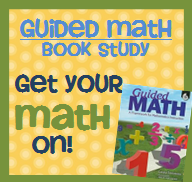“Using Guided Math With Small Groups”
Thanks to Mary at Pitner's Potpourri and Alison at Toad-ally Exceptional Learners for hosting Chapter 5.
Advantages of Small-Group Instruction
By flexibly grouping students based on their strengths and needs, teachers can tailor their teaching to provide the specific instruction that best challenges all learners.
Mathematical communication is an integral aspect of small-group mathematics lessons. Teachers learn when to move ahead with instruction, when more teaching is needed, and what specific points need to be addressed for these learners-all of which help teachers as they plan future instruction to extend learning.
If students are making errors in their work due to misconceptions or even carelessness, the teacher notice immediately. An essential component of instruction is assessment. That includes formal, informal, summative, and formative assessments. Using small-group instruction teachers learn about their students and their abilities.
Challenges of Small-Group Instruction
Teachers who use small-group instruction are involved in more complex tasks as they plan. This type of planning is only possible when teachers know their students’ levels of achievement and learning needs extremely well.
Effective Uses of Small-Group Instruction
- differentiating instruction
- teaching mathematical “hot spots”
- teaching with manipulatives
- assessing student learning informally
- supporting mathematics process standards
Forming Small Groups for Learning
- Unit Pre-tests
- Formative Tests
- Performance Tasks
- Observations of Student Work
- Mathematical Conversations with Students
- Benchmark Tests
Organizing for Small-Group Instruction
When the meeting space is clearly defined and any materials needed are prepared and readily available at the beginning of each math class, group instruction can begin promptly.
Suggested items available during small-group instruction:
- whiteboards
- chart pad and easel
- work mats
- manipulatives
- measuring tools
- paper
- pencils
- erasers
- crayons
- markers
- specific materials for the lesson planned
Guided Math Lesson for Small Groups
Planning the Lesson
- Determine the big ideas of the unit of study to be taught based on the standards and the needs of the students.
- Decide what the criteria of success will be in mastering the standards of the unit.
- Use information from assessments (both formal and informal) to form groups based on student needs.
- Select specific teaching points for each group.
- Prepare differentiated lessons based on the learning needs of the students in each group.
- Gather and organize the materials necessary for the lesson.
Teaching a Guided Math Lesson with a Small Group
Guided Math in a Small Group
- Briefly introduce the lesson by providing supportive strategies for learners through a mini lesson to introduce or extend the concepts being learned.
- Provide students with a clear understanding of the activity or task on which they will work, including setting criteria for success.
- Encourage students to use a variety of strategies to solve the problem or complete the activity.
- Scaffold student learning by giving just enough support to move students to the next level of understanding and proficiency.
- Provide ample opportunities for mathematical discourse.
- Give students specific, descriptive feedback on their work and encourage students to engage in self-assessment based on the criteria for success.
Teacher Reflection after the Lesson
- Record and organize informal assessment information based on observations and conversations.
- Select the next steps in learning for the group, as well as for individual students.
- Identify students who are struggling with specific concepts, and plan how to reteach the concept when needed.
- Change the composition of the groups, when appropriate.
Review and Reflect
- How does using flexible, needs-based grouping affect student learning? How can it affect teaching strategies employed by teachers? Students learning should increase as students are taught in flexible small groups. As a teacher I can target specific skills or misconceptions and focus on them with the students who need it. I will use more targeted strategies and continue to try and build conceptual understanding for struggling learners. It will also be a chance for more targeted literacy strategies to be employed.
- Question 2 was on Guided Reading and since I only teach math I skipped it.
- What data do you have that can guide you as you create small groups of students for Guided Math instruction? I can use MAPs data to see the math strands that groups of students struggle with. I can use pretest information for grouping students, as well as formative assessments like exit slips and in class checks. By observing students and talking to them as they work on their math I can also gain valuable information for grouping them. I will be using Carnegie math next year and there many reports that will be generated by the cognitive software that students will use. This should also prove very helpful for putting students into small groups.










